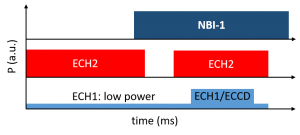TJ-II:Searching for AEs suppression scenarios using off-axis ECCD
Experimental campaign
Spring 2022
Proposal title
Searching for AEs suppression scenarios using off-axis ECCD
Name and affiliation of proponent
Á. Cappa, J. Martínez, E. Ascasíbar, K.J. McCarthy, P. Pons, T. Estrada, D. Zarzoso, C. Hidalgo
Details of contact person at LNF
If applicable, enter contact person here or write N/A
Description of the activity
The goal of the proposal is to find ECRH launching configurations for which the amplitude of NBI-driven Alfvén Eigenmodes (AEs) is mitigated. Besides the interest that such scenarios have for the fast particles topic, studies of coupling between NBI-driven AEs and low frequency zonal flows may also benefit from them. Many scenarios making use of different "control" parameters have already been tested in past experimental sessions, showing always strong changes in AEs activity. Plasma density variations and changes of the rotational transform profile due to the many contributions to the total plasma current (NBCD, ECCD, Bootstrap current) are the parameters with the higher impact. However, although inducing modifications in the general spectrum of the excited modes, none of the investigated scenarios show a clear possibility to suppress AEs without inducing large changes in plasma parameters, being the most promising the one employing ECCD. In this particular case we intend to investigate the effect of off-axis ECCD at different plasma radius.
Experimental plan

Until now, only ECCD on-axis has been investigated. We will now try to modify the rotational transform profile by inducing ECCD off-axis with different levels of power at different plasma radius. The success of the proposal depends on whether or not the gyrotron that will be used to drive the current (ECH1) can be operated as shown in figure 1. To this end, previous tube conditionning sessions will be needed to ensure that the gyrotron can work with different levels of anode voltage in the same shot and thus deliver different levels of power. The heating power set-up shown in figure 1 will allow us to investigate the effect of ECCD using different combinations of ECH1 beam power and ECCD efficiency. With this set-up, ECH2 power (always with ) is used for start-up and density control in the NBI phase. Ideally, there should be no power in the first gyrotron until the central part of the NBI phase, in which the reference shot with in ECH1 will be compared to the shots obtained by changing the injection direction of ECH1. For stability purposes of the gyrotron, and depending on the result of the conditionning tests, a small amount of power may be required from the begginning of the shot until higher power is requested.
International or National funding project or entity
Include funding here (grants, national plans)
Description of required resources
Required resources:
- Number of plasma discharges or days of operation: One day - 20 useful shots
- Essential diagnostic systems: Besides the common shot to shot diagnostics (ECE, Thomson, Interferometry, Radiation), all systems providing edge plasma profiles are needed. Moreover, HIBP to measure mode radial structure, Doppler Reflectometer, Mirnov coils (both helical and poloidal arrays) and CNPA measurements are mandatory. MSE would also be desirable to measure changes induced by ECCD. FILD is also desirable in order to monitor the different levels of fast ions losses in each heating configuration.
- Type of plasmas (heating configuration): ECRH + NBI-1 hydrogen plasmas following the heating scheme shown in Figure 1.
- Specific requirements on wall conditioning if any:
- External users: need a local computer account for data access: no
- Any external equipment to be integrated? Provide description and integration needs: no
Preferred dates and degree of flexibility
Preferred dates: (format dd-mm-yyyy)
References